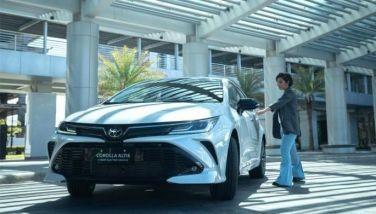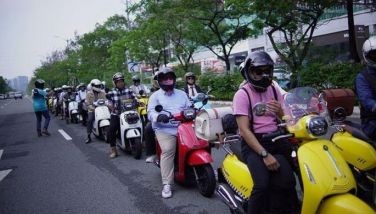Mudblood: Mitsubishi Pajero GLS
December 7, 2005 | 12:00am
The drive from Manila to Sagada, the Sagada of the legendary caves and "pre-commercialized and polluted Baguio" fame is no joke. At something over 400 kilometers from Balintawak to the famous Saint Joseph’s Resthouse of Sagada, where heated water is not a guarantee, it will take anywhere from 9 nauseous hours to a more leisurely, but nonetheless exhausting 11… not counting Kodak moments by the Banaue rice terraces or impromptu pee breaks.
Why so long? Because almost half of the roads going there are, ahh, a work in progress. You can get there via either of two routes: through Banaue with the scenic rice terraces for visual entertainment, or via Baguio and the ironically-named Hanselma Highway. More than ten years ago, when Sagada was but a little-known town to the average Manileño and probably more identified as a sort of cheap nirvana high in the clouds (and far from authorities) for the weed-indulging connoisseur, I braved the trip with my brother and late father via the old-fashioned way: commuting.
Spending the better part of the day in a cramped bus with odor-rific European backpackers, followed by another day hanging onto the roof of an overloaded jeepney that randomly tossed baggage into the ravines at every hairpin, what can I say? I loved it, because the reward at the end of that trying journey was like a time warp into simpler times, where cheap food, clean air, pleasant locals, and the scent of pine trees all around could tempt any adventurous spirit into spending a week or forty-eight there.
Today, Sagada is very nearly on the doorstep of modern civilization. Walk down the main road and you can e-mail your friends at most of the quaint little restaurants. Ask around for what else is there to do besides explore the well-known caves and the locals might just tell you to explore the trails on your mountain bike. What’s more, the guides for that kind of escape aren’t Filipinos, but rather Americans, Peace Corps and ex-Peace Corps fellows that liked the place so much they’ve decided to call Sagada their home. Naturally, everyone else thinks they’re with the CIA.
Of course, you still have to get there to experience all this for yourself. If you only own a passenger car, you can forget about bringing it. The minimum you’ll need is a cheap AUV or truck that you won’t mind banging up every kilometer or so with the thousands of melon-sized rocks that litter the roads to Sagada. A 4x2 is okay. Heck, the locals drift around the hairpins and their thousand-foot cliffs on tires a hair width away from being unusable. However, the best rig is anything with four-wheel drive. That extra hardware will give you traction in moments when you don’t think you need it but really do, such as steep and slippery slopes, of which the Mountain Province has many.
In this regard, we were veritable Boy Scouts. The whole idea being to drive all the way there just to ride our bikes on the invite of Anthony Mendoza (part owner of Sabak Sports), the latter met up with us in his trusty Isuzu pickup truck. Also with us was Tony Cancio, part owner of Sabak Sports, in a very capable (not to mention exquisitely fashionable) Land Rover Defender 110. Meanwhile, Mitsubishi Motors lent us the keys to their all-singing, all-dancing, diesel-powered Pajero. What it lacked in safari-appeal compared to the Defender, it made up for in 21st century style. What it may have lacked in true, hard-core, off-road grunt compared to the Rover, it made up for in comfort.
At around 2.6 million a copy, the Pajero is not cheap. Hence, our wariness at plunging it into the first ravine that we saw just to see if it could extricate itself from said obstacle like the Defender. However, it is also a very capable, long-distance cruiser as we would find out over the course of the 900 kilometer round trip. Said amount of cash gets you a 3.2-liter, direct injection turbodiesel matched to a 5-speed automatic. It makes all the sophisticated noises of a 60’s-era Sarao, but also all the power of, oh, several rampaging elephants. On paper, it makes 165 horsepower and 37.8 kg-m of torque, but it feels like much more in real-world driving. Whereas the old Pajero (in its last "Field Master" trim) felt slack and heavy, this one feels frisky and athletic at any speed below 130kph. It will, in fact, top out at close to 180kph given enough open road, terminal velocity dictated more by its barn door aerodynamics than by a lack of power.
So, it gobbled up the paved roads all the way to Banaue with ease, practically straining at the leash to lead the convoy being led by the Rover’s sedate 100. Past Banaue, the road quickly degenerates into hard-packed gravel and rock. Sometimes, landslides are in the way. On our non-stop trip, we made Banaue by 6:30AM, power napped at a viewpoint for a few minutes, then drove on to Sagada that morning in fog and 30-foot visibility all the way until Bontoc.
Shifting from 2WD to 4WD-High with ease (it’s an electronic system), we averaged between 30 to 40 kph on this road, twice the speed your average bag-and-passenger-ejecting jeepney will do. Making good time, with the truck just flowing along the road, rhythmically absorbing the bumps and ruts without missing a beat, we were momentarily alarmed by an incessant beeping from the tire pressure monitoring system. Aha! A flat!
After removing a 4-inch nail from the left-front tire and then sealing it quickly with those kits that look like they’ll do even more damage to the tire than actually fix it, we were back to speed in almost no time at all. Except the monitor wouldn’t stop beeping. Beeping system notwithstanding, we made it to Saint Joseph’s in 11 hours, 1 and 1/2 of which was spent at rest stops.
With the rest of the day and the next spent exploring Sagada, we promptly forgot about the Pajero as it rested in the parking lot. Then it was time to load up again and go home. All told, it was big enough for three people (1 more would have fit, although the backseat would have been rendered un-sleepable), one cooler, 6 large duffel bags, 2 full-size mountain bikes, 3 hand carved stools, and several kilos worth of mountain tea leaves. Really, that was tea.
Choosing to take the Hanselma Highway to Baguio this time, we made the 150-kilometer, rough road trip in 4 hours. Along the way, the bleeping beeping finally shut up, ceasing to nag us with the prospect of another flat in the middle of nowhere. Foglamps blazing and four-wheel drive churning away, trucks, buses, jeeps, and lesser SUVs plying the route courteously pulled to the side as we powered past them with nary a care about slipping off and into oblivion far, far below. Apart from a lone Field Master that attempted to drop us before stopping and letting an incredibly carsick amo out, the drive was quick but uneventful… as it should be.
In fact, I felt energetic enough upon reaching Baguio that I didn’t bother relinquishing the helm for the last 300 kilometers to Manila. Returning to the city in another four and half hours, I felt tired but none the worse for wear. It’s not often an SUV takes most of the punishment away from you. Despite the heavy-duty, all-independent suspension, the monocoque-bodied Pajero displayed cat-quick responses all the way. Despite this flogging, the Pajero returned a very pleasing 11 kilometers per liter of fuel economy.
The next day, it attracted more stares on the road than when I drove around in a borrowed Porsche 911 years ago. This is because about an inches’ worth of mud had encrusted itself to every square inch of the Pajero’s body, such that the local car wash boys fled their shop on my arrival. Mudblood? For long drives where the road isn’t always, well, a road, the Pajero revels in the title.
Why so long? Because almost half of the roads going there are, ahh, a work in progress. You can get there via either of two routes: through Banaue with the scenic rice terraces for visual entertainment, or via Baguio and the ironically-named Hanselma Highway. More than ten years ago, when Sagada was but a little-known town to the average Manileño and probably more identified as a sort of cheap nirvana high in the clouds (and far from authorities) for the weed-indulging connoisseur, I braved the trip with my brother and late father via the old-fashioned way: commuting.
Spending the better part of the day in a cramped bus with odor-rific European backpackers, followed by another day hanging onto the roof of an overloaded jeepney that randomly tossed baggage into the ravines at every hairpin, what can I say? I loved it, because the reward at the end of that trying journey was like a time warp into simpler times, where cheap food, clean air, pleasant locals, and the scent of pine trees all around could tempt any adventurous spirit into spending a week or forty-eight there.
Today, Sagada is very nearly on the doorstep of modern civilization. Walk down the main road and you can e-mail your friends at most of the quaint little restaurants. Ask around for what else is there to do besides explore the well-known caves and the locals might just tell you to explore the trails on your mountain bike. What’s more, the guides for that kind of escape aren’t Filipinos, but rather Americans, Peace Corps and ex-Peace Corps fellows that liked the place so much they’ve decided to call Sagada their home. Naturally, everyone else thinks they’re with the CIA.
Of course, you still have to get there to experience all this for yourself. If you only own a passenger car, you can forget about bringing it. The minimum you’ll need is a cheap AUV or truck that you won’t mind banging up every kilometer or so with the thousands of melon-sized rocks that litter the roads to Sagada. A 4x2 is okay. Heck, the locals drift around the hairpins and their thousand-foot cliffs on tires a hair width away from being unusable. However, the best rig is anything with four-wheel drive. That extra hardware will give you traction in moments when you don’t think you need it but really do, such as steep and slippery slopes, of which the Mountain Province has many.
In this regard, we were veritable Boy Scouts. The whole idea being to drive all the way there just to ride our bikes on the invite of Anthony Mendoza (part owner of Sabak Sports), the latter met up with us in his trusty Isuzu pickup truck. Also with us was Tony Cancio, part owner of Sabak Sports, in a very capable (not to mention exquisitely fashionable) Land Rover Defender 110. Meanwhile, Mitsubishi Motors lent us the keys to their all-singing, all-dancing, diesel-powered Pajero. What it lacked in safari-appeal compared to the Defender, it made up for in 21st century style. What it may have lacked in true, hard-core, off-road grunt compared to the Rover, it made up for in comfort.
At around 2.6 million a copy, the Pajero is not cheap. Hence, our wariness at plunging it into the first ravine that we saw just to see if it could extricate itself from said obstacle like the Defender. However, it is also a very capable, long-distance cruiser as we would find out over the course of the 900 kilometer round trip. Said amount of cash gets you a 3.2-liter, direct injection turbodiesel matched to a 5-speed automatic. It makes all the sophisticated noises of a 60’s-era Sarao, but also all the power of, oh, several rampaging elephants. On paper, it makes 165 horsepower and 37.8 kg-m of torque, but it feels like much more in real-world driving. Whereas the old Pajero (in its last "Field Master" trim) felt slack and heavy, this one feels frisky and athletic at any speed below 130kph. It will, in fact, top out at close to 180kph given enough open road, terminal velocity dictated more by its barn door aerodynamics than by a lack of power.
So, it gobbled up the paved roads all the way to Banaue with ease, practically straining at the leash to lead the convoy being led by the Rover’s sedate 100. Past Banaue, the road quickly degenerates into hard-packed gravel and rock. Sometimes, landslides are in the way. On our non-stop trip, we made Banaue by 6:30AM, power napped at a viewpoint for a few minutes, then drove on to Sagada that morning in fog and 30-foot visibility all the way until Bontoc.
Shifting from 2WD to 4WD-High with ease (it’s an electronic system), we averaged between 30 to 40 kph on this road, twice the speed your average bag-and-passenger-ejecting jeepney will do. Making good time, with the truck just flowing along the road, rhythmically absorbing the bumps and ruts without missing a beat, we were momentarily alarmed by an incessant beeping from the tire pressure monitoring system. Aha! A flat!
After removing a 4-inch nail from the left-front tire and then sealing it quickly with those kits that look like they’ll do even more damage to the tire than actually fix it, we were back to speed in almost no time at all. Except the monitor wouldn’t stop beeping. Beeping system notwithstanding, we made it to Saint Joseph’s in 11 hours, 1 and 1/2 of which was spent at rest stops.
With the rest of the day and the next spent exploring Sagada, we promptly forgot about the Pajero as it rested in the parking lot. Then it was time to load up again and go home. All told, it was big enough for three people (1 more would have fit, although the backseat would have been rendered un-sleepable), one cooler, 6 large duffel bags, 2 full-size mountain bikes, 3 hand carved stools, and several kilos worth of mountain tea leaves. Really, that was tea.
Choosing to take the Hanselma Highway to Baguio this time, we made the 150-kilometer, rough road trip in 4 hours. Along the way, the bleeping beeping finally shut up, ceasing to nag us with the prospect of another flat in the middle of nowhere. Foglamps blazing and four-wheel drive churning away, trucks, buses, jeeps, and lesser SUVs plying the route courteously pulled to the side as we powered past them with nary a care about slipping off and into oblivion far, far below. Apart from a lone Field Master that attempted to drop us before stopping and letting an incredibly carsick amo out, the drive was quick but uneventful… as it should be.
In fact, I felt energetic enough upon reaching Baguio that I didn’t bother relinquishing the helm for the last 300 kilometers to Manila. Returning to the city in another four and half hours, I felt tired but none the worse for wear. It’s not often an SUV takes most of the punishment away from you. Despite the heavy-duty, all-independent suspension, the monocoque-bodied Pajero displayed cat-quick responses all the way. Despite this flogging, the Pajero returned a very pleasing 11 kilometers per liter of fuel economy.
The next day, it attracted more stares on the road than when I drove around in a borrowed Porsche 911 years ago. This is because about an inches’ worth of mud had encrusted itself to every square inch of the Pajero’s body, such that the local car wash boys fled their shop on my arrival. Mudblood? For long drives where the road isn’t always, well, a road, the Pajero revels in the title.
BrandSpace Articles
<
>
- Latest
Latest
Latest
September 30, 2024 - 4:26pm
By EC Toledo | September 30, 2024 - 4:26pm
September 26, 2024 - 3:30pm
September 26, 2024 - 3:30pm
August 16, 2024 - 11:00am
By Euden Valdez | August 16, 2024 - 11:00am
Recommended



























